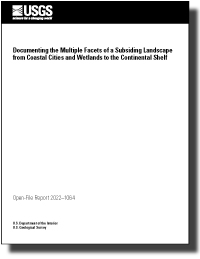Documenting the Multiple Facets of a Subsiding Landscape from Coastal Cities and Wetlands to the Continental Shelf
Links
- Document: Report (10 MB pdf)
- Download citation as: RIS | Dublin Core
Abstract
Land subsidence is a settling, sinking, or collapse of the land surface. In the southeastern United States, subsidence is frequently observed as sinkhole collapse in karst environments, wetland degradation and loss in coastal and other low-lying areas, and inundation of coastal urban communities. Human activities such as fluid extraction, mining, and overburden alteration can cause or exacerbate subsidence, which can result in damage to infrastructure and resources. Subsidence is a hazard that takes place throughout the United States; however, a systematic approach to recognize and develop informed responses to the drivers of subsidence has not yet been fully established. To address this problem, the U.S. Geological Survey (USGS) Southeast Region (SER) funded the gathering of a team of interdisciplinary USGS scientists to promote scientific collaboration. Southeast Region scientists welcomed scientists from other regions (see table 1.1 in Appendix 1) in September 2018 at the St. Petersburg Coastal and Marine Science Center (SPCMSC) in Florida for the first workshop of the Subsidence Flex Team (SFT) (see Appendix 2 for agenda). The SFT set out to review subsidence-related research and technology and develop a unifying framework for describing the processes and hazards associated with land subsidence. A more comprehensive understanding of subsidence hazards could help to inform regional vulnerability assessments that would prove invaluable to the public, community developers, policy makers, and resource managers in both inland and coastal states. The SFT analyzed USGS strengths and weaknesses to identify existing infrastructure and capabilities that could be leveraged to create a comprehensive and far-reaching subsidence-monitoring and mitigation program. Over the course of the 2-day workshop, interdisciplinary understandings of the processes and hazards related to subsidence were explored through individual presentations and group discussion. With all perspectives considered, the SFT recommended that subsidence-related research develop scientific approaches and metrics by which the subsidence component can be isolated and quantified in order to protect both the environment and human infrastructure from harm.
Suggested Citation
Flocks, J., McGraw, E., Barras, J., Bernier, J., Bradley, M., Galloway, D., Landmeyer, J., McBride, W.S., Smith, C., Smith, K., Swarzenski, C., and Toth, L., 2022, Documenting the multiple facets of a subsiding landscape from coastal cities and wetlands to the continental shelf: U.S. Geological Survey Open-File Report 2022–1064, 22 p., https://doi.org/10.3133/ofr20221064.
ISSN: 2331-1258 (online)
Study Area
Table of Contents
- Acknowledgments
- Abstract
- Introduction
- Summary of Workshop Presentations
- Key Findings
- Knowledge Gaps
- The Potential Role of USGS in Subsidence-Related Research
- Goals for Future Efforts
- Conclusion
- References Cited
- Appendix 1
- Appendix 2
| Publication type | Report |
|---|---|
| Publication Subtype | USGS Numbered Series |
| Title | Documenting the multiple facets of a subsiding landscape from coastal cities and wetlands to the continental shelf |
| Series title | Open-File Report |
| Series number | 2022-1064 |
| DOI | 10.3133/ofr20221064 |
| Publication Date | August 02, 2022 |
| Year Published | 2022 |
| Language | English |
| Publisher | U.S. Geological Survey |
| Publisher location | Reston, VA |
| Contributing office(s) | FLWSC-Ft. Lauderdale, St. Petersburg Coastal and Marine Science Center, South Atlantic Water Science Center, Lower Mississippi-Gulf Water Science Center, Ohio-Kentucky-Indiana Water Science Center |
| Description | viii, 22 p. |
| Country | United States |
| State | Alabama, Florida, Louisiana, Mississippi |
| Online Only (Y/N) | Y |


